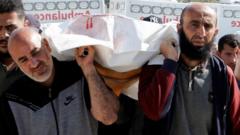Uncertainties surrounding casualty reports in Gaza persist as the health ministry denies manipulative practices while Israel contests claims of inflated figures.
**Gaza Health Ministry Defends Accuracy of Death Toll Amid Controversy**

**Gaza Health Ministry Defends Accuracy of Death Toll Amid Controversy**
The health ministry in Gaza, governed by Hamas, faces scrutiny over its reported death toll figures as conflicts and questions of transparency arise.
The article text:
Gaza's Hamas-led health ministry is standing by its reported death toll of over 51,200 Palestinians amid accusations of manipulation from Israel and its allies. In the wake of the ongoing Gaza war, tragedies continue to unfold, as evinced by the recent harrowing scene at al-Shifa Hospital in Gaza City, where Alam Hirzallah mourned the loss of his family members following an Israeli bombing.
With nearly a third of the reported deaths being children, the ministry’s figures are not without contention. Israel has consistently disputed the casualty count, arguing that it serves as propaganda by Hamas. To substantiate its claims, Israel points to discrepancies within the death toll records, which have shown changes over time and suggest manipulation by Hamas.
Recent media reports highlighted that about 3,000 names were removed from earlier deceased lists, prompting questions regarding their reliability. In response to these allegations, Zaher al-Wahidi, a health official in Gaza, insisted that the names being revised were part of an ongoing verification process rather than an act of censorship or fraud. “The health ministry works towards having accurate data with high credibility,” he stated.
As the method of recording deaths has evolved due to increased chaos, earlier counts were based on bodies arriving at hospitals. As violence escalated, reliable information has proved more challenging to gather. Gazan health representatives began utilizing online forms to report fatalities in an attempt to streamline this process, but this too has led to complications, including erroneous listings of deceased individuals and the inclusion of those who passed away from non-conflict-related causes.
In light of the ongoing conflict, significant challenges remain for Gazans attempting to retrieve and identify loved ones buried under rubble or lost due to airstrikes. Notably, the absence of direct DNA testing complicates the identification process, making it reliant on personal effects to determine identities.
Simultaneously, Israel does not publicly dispute the names officially listed in Gaza; however, it asserts that a large proportion of those counted among the dead are combatants, estimating around 20,000 fighters killed, a claim the Palestinian side does not recognize. International journalists face obstacles in verifying figures independently, relying instead on local sources for information, which complicates the accuracy of casualty reporting.
The stark contrast in narratives showcases the deepening rift between the two sides, with figures rising on both fronts while the humanitarian crisis in Gaza intensifies. As the war, which reignited on October 7, 2023, following a Hamas-led attack on Israel, ensues without a definitive resolution in sight, the plight of civilians remains the foremost concern amid ongoing hostilities and contested statistics.
Gaza's Hamas-led health ministry is standing by its reported death toll of over 51,200 Palestinians amid accusations of manipulation from Israel and its allies. In the wake of the ongoing Gaza war, tragedies continue to unfold, as evinced by the recent harrowing scene at al-Shifa Hospital in Gaza City, where Alam Hirzallah mourned the loss of his family members following an Israeli bombing.
With nearly a third of the reported deaths being children, the ministry’s figures are not without contention. Israel has consistently disputed the casualty count, arguing that it serves as propaganda by Hamas. To substantiate its claims, Israel points to discrepancies within the death toll records, which have shown changes over time and suggest manipulation by Hamas.
Recent media reports highlighted that about 3,000 names were removed from earlier deceased lists, prompting questions regarding their reliability. In response to these allegations, Zaher al-Wahidi, a health official in Gaza, insisted that the names being revised were part of an ongoing verification process rather than an act of censorship or fraud. “The health ministry works towards having accurate data with high credibility,” he stated.
As the method of recording deaths has evolved due to increased chaos, earlier counts were based on bodies arriving at hospitals. As violence escalated, reliable information has proved more challenging to gather. Gazan health representatives began utilizing online forms to report fatalities in an attempt to streamline this process, but this too has led to complications, including erroneous listings of deceased individuals and the inclusion of those who passed away from non-conflict-related causes.
In light of the ongoing conflict, significant challenges remain for Gazans attempting to retrieve and identify loved ones buried under rubble or lost due to airstrikes. Notably, the absence of direct DNA testing complicates the identification process, making it reliant on personal effects to determine identities.
Simultaneously, Israel does not publicly dispute the names officially listed in Gaza; however, it asserts that a large proportion of those counted among the dead are combatants, estimating around 20,000 fighters killed, a claim the Palestinian side does not recognize. International journalists face obstacles in verifying figures independently, relying instead on local sources for information, which complicates the accuracy of casualty reporting.
The stark contrast in narratives showcases the deepening rift between the two sides, with figures rising on both fronts while the humanitarian crisis in Gaza intensifies. As the war, which reignited on October 7, 2023, following a Hamas-led attack on Israel, ensues without a definitive resolution in sight, the plight of civilians remains the foremost concern amid ongoing hostilities and contested statistics.




















